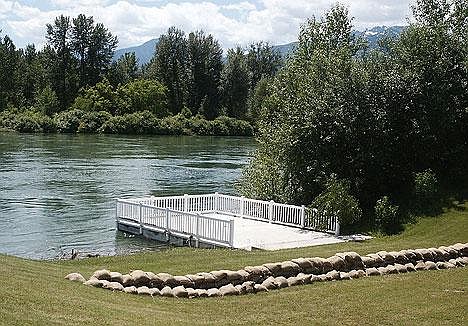Spillways close at Libby Dam
The spillways at Libby Dam are closed for the first time in 19 days and releases from the dam are down to 23,423 cubic-feet per second as of Wednesday afternoon.
The flows in the Kootenai River below the dam are down more than 50 percent from the unprecedented 55,000 cfs that was released on Monday, June 19. That included 31,000 cfs coming down the spillway, which started Saturday, June 17, because of weather and river forecasts calling for high inflows into Lake Koocanusa from Canada.
Lincoln County Emergency Services Management director Mark McGill reported getting some calls from landowners along the river
worried because it was not known how much higher the river would rise.
"There were some people who needed sandbags," McGill said.
The biggest problem came from people who had reshaped the land along the river to have a view of the water from their daylight basements, he said.
"When you live along the river and do that kind of landscaping, you have to protect yourself," McGill said.
He helped serve people with sandbags.
Julie Shadle, who lives on the river with husband Jim at the Northwood subdivision north of Libby, called McGill when the river levels topped her cantilevered deck on June 17. Shadle said the deck usually sits above dry rocks but water was flowing over the top and climbing up through the lawn.
Before Shadle had time to think, three women and 11 youngsters showed up to fill sandbags and line them up across the low spot in the lawn. Friend Tom Fennessey used his truck to ferry the filled sandbags to where they were needed.
"I was just so grateful that all of these people just showed up," Shadle said.
"That's what Libby does, and that's what Lincoln County does, people take care of each other," McGill said.
Along the river, McGill said, there was some damage to riverside landscaping, some seepage into lawns and water in some basements upstream and downstream of Libby.
"All in all, we did pretty well," he said. "We did quite a bit better than Bonners Ferry did."
The Bonners Ferry area is reporting extensive damage to dikes, agricultural fields and crops, and there was some basement flooding at the Kootenai River Inn on the edge of the downtown area.
McGill said the dam did its job in terms of how much water was flowing into the reservoir but the U.S. Army Corps of Engineers was forced to release more water than has been seen in the river since the dam began operating in the mid 1970s.
What remains unknown is how much damage has been done to the river fishery. Montana Fish, Wildlife and Parks biologists had done some electro-shocking over a week ago and found every bull trout sampled had gas bubble trauma. Biologists reported seeing bubbles in eyes, in fins and fish had split fins, also believed to be caused by gas bubble trauma.
About 80 percent of last week's samples of rainbow and cutthroat trout had symptoms, and about 70 percent of mountain whitefish showed symptoms.

